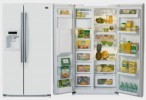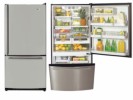Yet Another Remarkable Buying Guide from US Appliance. I couldn't have written it better myself!
Questions, send them to us on our new forums!
Visit Our Forums for DIY Questions & More
Food for thought,
ArchAngel
US Appliance Buying Guideshttp://www.us-appliance.com/rebugu.html

There are many different types of refrigerators available today. Consider the differences between some of the most common types.
| 
| Top-Mount freezer refrigerators
A top-mount fridge has the freezer at eye level, with the fresh food compartment on the bottom. These fridges tend to have wider shelves in both the fridge and freezer sections. Traditionally this has been the most common type of refrigerator although some of the other styles are becoming very popular.
 View our Top mount refrigerators View our Top mount refrigerators
|
|  | Side-by-side refrigerators
The refrigerator and freezer compartments are adjacent to one another and allow easy access to both compartments. Look carefully at the capacity and flexibility of the interior. In some models the shelves are narrower than those found in top or bottom-mount models, and may not accommodate larger items like bulky pizza boxes or gallon-sized containers. If possible select a model with adjustable bins and shelves so that you can customize the layout to suit your storage needs.
 View our Side-by-Side refrigerators View our Side-by-Side refrigerators
|
|  | Freezer on Bottom
The bottom mount freezer is a good option for households that want fresh food selections at eye level. With the freezer at the bottom of the fridge, less energy is used to keep the section cold, and cooling is more consistent and even.
The configuration makes a lot of sense ergonomically, as well. Typically, the freezer is used less often than the fridge, and the most frequently used fridge sections are located in the top compartment for easy access.
 View our Bottom-Mount refrigerators View our Bottom-Mount refrigerators |
| 
| French Door
An increasingly popular style of refrigerator that has dual refrigerator doors and a pullout freezer drawer for convenient fresh and frozen food storage. This style combines the best features of the Bottom Mount and Side-by-Side refrigerators.
 View our French Door refrigerators View our French Door refrigerators |

Selecting a refrigerator that is the right size is important. If you buy one that is too big and don't keep it filled, it wastes energy and costs more to operate. If it is too small, you waste time constantly rearranging food trying to make it all fit.
|
|  |  Consider the capacity of your current refrigerator and how well it fits your groceries before you decide to increase or decrease the size of your model. Consider the capacity of your current refrigerator and how well it fits your groceries before you decide to increase or decrease the size of your model.
 A good rule of thumb - Two people generally need between 16-20 cubic feet of fresh food storage and you should probably add an extra cubic foot for each additional person in your family. A good rule of thumb - Two people generally need between 16-20 cubic feet of fresh food storage and you should probably add an extra cubic foot for each additional person in your family.
 Be sure to consider both your frozen and fresh food needs when selecting a particular model. Be sure to consider both your frozen and fresh food needs when selecting a particular model.
|

No matter if you just want a refrigerator that matches the rest of your kitchen or you want one that seamlessly blends with the rest of your interior the choices offered are varied.
|
| 
| Counter-depth Refrigerators
 Refrigerators can often extend several inches past the cabinets in your kitchen but counter-depth refrigerators offer a more shallow profile designed to fit flush with your cabinetry and create a beautiful appearance. Refrigerators can often extend several inches past the cabinets in your kitchen but counter-depth refrigerators offer a more shallow profile designed to fit flush with your cabinetry and create a beautiful appearance.
|
|  | Refrigerator Doors
 Door may be contoured, hinges may be hidden to give an elegant contemporary look, or flat doors may offer a modern look. Door may be contoured, hinges may be hidden to give an elegant contemporary look, or flat doors may offer a modern look.
|
Exterior Colors & Finishes
 Many refrigerators come standard in colors such as black and white to match many decors. (Biscuit, another common color offered, is slowly losing popularity) Many refrigerators come standard in colors such as black and white to match many decors. (Biscuit, another common color offered, is slowly losing popularity)
 Stainless steel has also become very popular in refrigerators. Some manufacturers offer a stainless steel look at a lower cost. Sometimes referred to as 'clean steel' this finish resists fingerprints and is easy to maintain. Stainless steel has also become very popular in refrigerators. Some manufacturers offer a stainless steel look at a lower cost. Sometimes referred to as 'clean steel' this finish resists fingerprints and is easy to maintain.
 Refrigerator trim kits convert your free-standing refrigerator to a built-in look. The trim panel is either an aluminum or colored panel provided by the refrigerator manufacturer, or a panel is provided by your decorator, to exactly match the rest of your kitchen cabinetry. Refrigerator trim kits convert your free-standing refrigerator to a built-in look. The trim panel is either an aluminum or colored panel provided by the refrigerator manufacturer, or a panel is provided by your decorator, to exactly match the rest of your kitchen cabinetry. |

Today's refrigerators offer a number of features and extras designed to make food storage accessible and flexible to your particular storage needs.
Think about how much shelf and bin space you use and the shapes and sizes of items you normally store. The ability to organize groceries and manage space is very important.
|
| 

 |  Door-mounted ice makers and water dispensers provide filtered water and ice on demand without requiring the door to be opened. Door-mounted ice makers and water dispensers provide filtered water and ice on demand without requiring the door to be opened.
 Clear shelves and door bins help you see what you have, no matter where it is in the refrigerator, and provide better access to items stored in the back. Clear shelves and door bins help you see what you have, no matter where it is in the refrigerator, and provide better access to items stored in the back.
 Some models offer many options regarding where and how you can arrange your storage bins and shelves and store your food. Some models offer many options regarding where and how you can arrange your storage bins and shelves and store your food.
 Adjustable glass shelves will provide greater storage flexibility as your needs change. Adjustable glass shelves will provide greater storage flexibility as your needs change.
 Spill-proof shelves capture spills and prevent them from leaking all over the refrigerator. Spill-proof shelves capture spills and prevent them from leaking all over the refrigerator.
 Fruit and vegetable crispers often feature adjustable humidity controls, and meat compartments may feature adjustable temperature controls. Fruit and vegetable crispers often feature adjustable humidity controls, and meat compartments may feature adjustable temperature controls.
 Beverage compartments specifically to hold and dispense cans. Beverage compartments specifically to hold and dispense cans.
 Wine racks. Wine racks.
 Advanced lighting so that you can easily view fridge contents. Advanced lighting so that you can easily view fridge contents.
 Dispenser child locks. Dispenser child locks.
 Ice storage bins. Ice storage bins.
 Extra wide shelves. Extra wide shelves.
 Thawing/Defrosting capabilities. Thawing/Defrosting capabilities.
 Easy access slide out compartments and bins. Easy access slide out compartments and bins.
 Dairy/Cheese/Butter/Meat compartments. Dairy/Cheese/Butter/Meat compartments.
|
|
|  | Make sure it will fit!
 Measure the space that you have available for your refrigerator Know the height, width and depth of the area you want the new model to fit into. Measure the space that you have available for your refrigerator Know the height, width and depth of the area you want the new model to fit into.
 Be sure to take into account the clearances you will need in your kitchen to open refrigerator doors to remove pans and shelves. Be sure to take into account the clearances you will need in your kitchen to open refrigerator doors to remove pans and shelves.
 If you choose a refrigerator with an icemaker or ice and water dispenser, you will need to make sure you have access to a water line from behind the refrigerator for the water connections. If you choose a refrigerator with an icemaker or ice and water dispenser, you will need to make sure you have access to a water line from behind the refrigerator for the water connections.
|
| 
| Efficiency
 In a typical household the refrigerator can account for as much as 10 to 20 percent of total power you will use in one year. In a typical household the refrigerator can account for as much as 10 to 20 percent of total power you will use in one year.
 New models that are ENERGY STAR® qualified certified are extremely efficient. New models that are ENERGY STAR® qualified certified are extremely efficient.
 Refrigerators today typically use 30% less electricity than models built 10 years ago. For this reason, replacing an older refrigerator makes economical sense. Refrigerators today typically use 30% less electricity than models built 10 years ago. For this reason, replacing an older refrigerator makes economical sense.
|
|
 - Alarm - A visual or audible notification or warning feature to notify an open door or power failure.
- Bins - Storage areas designed primarily to keep meats, fruits and vegetables at optimum temperature levels.
- Bottom Mount Freezer - Refrigerator type where the freezer section is located on the bottom of the unit, the refrigerator is on top.
- Built-In - Appliance designed to be installed flush with the cabinetry
- Capacity - The measurement of the interior of the appliance, usually in cubic feet.
- Can Rack - Space-saving rack designed to stack canned beverages for automatic dispensing.
- Crushed Ice - Feature that allows user to select crushed ice from the dispenser rather than ice cubes
- Custom panels - Panels that can be fitted to a refrigerator to match your kitchen decor.
- Dairy Storage - Compartment for storing cheese, butter or dairy products.
- EnergyGuide Label - Estimated energy consumption on a scale showing a range for similar models. Estimated yearly operating cost based on the national average cost of electricity.
- Freezer basket - A storage basket in the freezer compartment that can be pulled open on rollers or gliders.
- Humidity Control - Available to control moisture levels or vegetable and fruit bins
- Insulation - Material such as foam or fiberglass installed between the interior walls and the exterior of the refrigerator and freezer to keep cold air from escaping and improve the efficiency of the refrigerator.
- Lock-out Feature - Common Water/Ice Dispenser feature to prevent children from dispensing water or ice without supervision
- Manufacturer Warranty - Manufacturer’s specified time period after purchase covering product defects. Coverage may be for parts and labor or parts only.
- Reversible Door - Door can be mounted to allow opening from right or left.
- Shelves - Refrigerator shelving can be customized for large and small items.
- Spill-proof shelves - Shelves have edges that prevent spills from dripping onto shelves below.
- Side-by-Side - Refrigerator type where the refrigerator and freezer compartments are adjacent to one another and allow easy access to both compartments.
- Top-Mount Freezer - Refrigerator type where the freezer compartment is on the top and the refrigerator on bottom.
- Water Dispenser - A feature that dispenser water/ice usually through the door. Requires connection to a water source.
|
![]()












No comments:
Post a Comment
Anyone may comment but we do delete spam. We love questions! Please also do not advertise here or post anything that would not be family friendly. Thank you